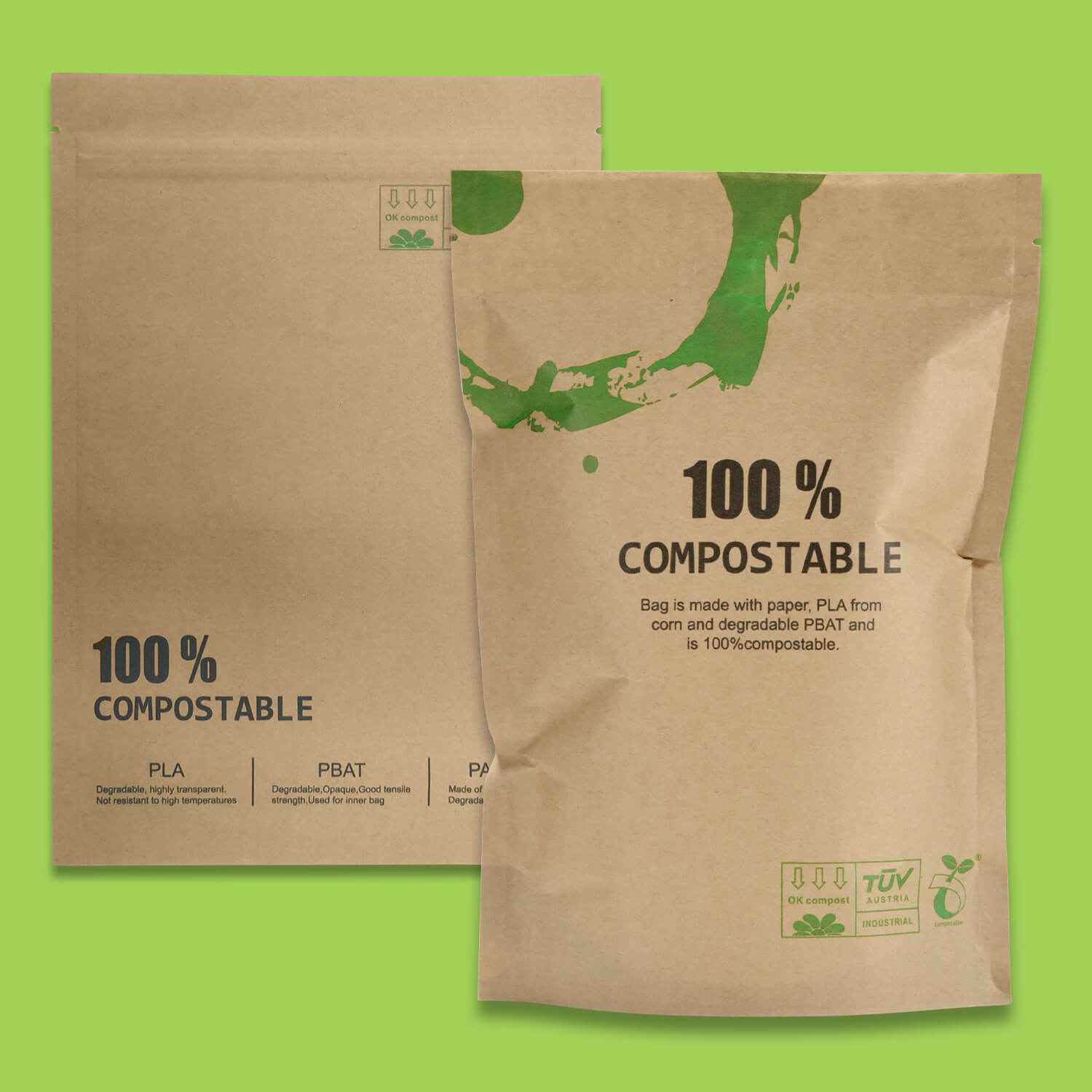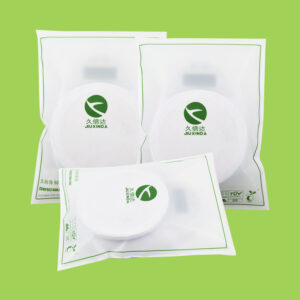Contents
What are compostable bags?
Compostable bags represent an innovative environmental solution. They are designed to break down in industrial composting facilities after use and are converted into environmentally friendly substances. Unlike traditional plastic packaging, these bags are usually made of biodegradable polymers, such as polylactic acid (PLA) or polyhydroxyalkanoates (PHA), which are derived from renewable resources such as corn starch or wood pulp.
The production process of these bags focuses on environmental protection and does not use harmful chemicals, ensuring that they are harmless to human health during use. They also have compostable certifications, such as ASTM D6400 or EN 13432 standards, which prove their ability to break down under industrial composting conditions.
The use of compostable bags helps reduce plastic pollution. They are particularly suitable for food packaging and other single-use occasions, because the waste generated by these occasions can be collected and sent to composting facilities and converted into beneficial soil conditioners. Such bags not only reduce dependence on non-renewable resources, but also promote the development of a circular economy by reducing the generation of plastic waste.
However, in order to realize their environmental potential, consumers and industry need to use and dispose of these bags correctly. This means that they should not be put into traditional recycling bins, but should be sent to industrial composting facilities or, if appropriate conditions are available, home composting. In this way, compostable bags can contribute to reducing environmental footprint and promoting sustainable development.
What are the advantages and disadvantages of compostable bags?
As an environmentally friendly alternative, compostable bags have the following advantages and disadvantages:
Advantages:
- Rapid decomposition: In industrial composting facilities, compostable bags can be completely decomposed into harmless substances such as carbon dioxide, water and biomass within a certain period of time without causing long-term pollution to the environment.
- Good physical properties: It has sufficient strength and toughness to withstand a certain amount of weight and tension, and has good moisture-proof, leak-proof and breathable properties to effectively protect the packaged items.
- Harmless to human health: It does not contain harmful chemicals such as bisphenol A (BPA) and phthalates, avoiding potential harm to the human body.
- Environmentally friendly production process: Renewable resources are usually used as raw materials, such as plant starch, cellulose, etc., which reduces dependence on non-renewable resources such as petroleum, and the energy consumption and pollutant emissions in the production process are relatively low.
- Support sustainable development: It helps to promote the sustainable development of society, reduce the generation and accumulation of plastic waste, protect the ecological environment, and promote the transformation, upgrading and technological innovation of related industries.
Disadvantages:
- Disposal issues: If consumers mistakenly throw compostable plastic containers into recycling bins, they may contaminate the surrounding recyclable waste. It is necessary to ensure that consumers understand the correct disposal methods.
- Recycling system compatibility: The introduction of compostable plastics may interfere with existing recycling systems because these systems were originally designed to handle commonly used packaging materials.
- Cost issues: Compostable packaging bags are generally more expensive than traditional plastic bags, which may affect their popularity and acceptance in the market.
- Decomposition condition restrictions: Compostable bags need to be decomposed in industrial composting facilities. Not every industrial composting facility accepts these bags. Some facilities can use compostable bags at all, while other facilities do not want to because they may cause non-compostable bag contamination.
- Difficulty of home composting: Home composters often find these bags difficult to decompose in backyard piles because they are designed for industrial sites and take a long time to decompose.
Compostable bags offer a potential solution to reduce plastic pollution, but their effectiveness and practicality are limited by their ability to decompose under proper handling and specific conditions.
Why do brands use compostable bags for product packaging?
There are many reasons why brands choose to use compostable bags, mainly based on environmental protection and sustainable development considerations. Here are some key reasons:
- Reduce plastic pollution: Traditional plastic bags take hundreds of years to decompose, while compostable bags can decompose in a shorter time under specific conditions, reducing the long-term impact of plastic waste on the environment.
- Improve brand image: Using compostable bags can enhance the brand’s environmental image and attract consumers who value sustainability and environmental protection.
- Meet regulatory requirements: As global restrictions and bans on plastic waste become increasingly stringent, using compostable bags can help brands comply with these regulations and avoid potential legal risks.
- Support the circular economy: Compostable bags support the principles of the circular economy, reducing the demand for new resources by recycling materials at the end of the product life cycle.
- Enhance consumer trust: When brands demonstrate their commitment to environmental responsibility, it can enhance consumer trust and loyalty to the brand.
- Promote innovation: Adopting compostable packaging bags can drive brands to innovate in packaging design and material selection and develop more environmentally friendly alternatives.
- Reduce greenhouse gas emissions: Compostable packaging bags reduce greenhouse gas emissions compared to traditional plastic waste during the decomposition process, helping to mitigate climate change.
- Improve compost quality: Using compostable packaging bags can improve the quality of compost because they do not leave harmful substances when they decompose, which helps improve soil health.
- Adapt to market trends: As consumers’ demand for sustainable products grows, using compostable packaging bags can help brands adapt to this market trend.
- Long-term cost savings: Although the initial cost of compostable packaging bags may be higher, in the long run, it may bring cost savings by reducing waste disposal and recycling costs, as well as avoiding potential fines due to environmental issues.
Using compostable packaging bags is a way for brands to demonstrate their environmental responsibility, and it is also a strategic decision that helps brands gain an advantage in a competitive market.
How to use compostable packaging bags?
Using compostable bags is an environmentally friendly and forward-looking decision that helps reduce plastic pollution and promotes sustainable development. To understand how to use these bags correctly, you first need to recognize their material properties. They are usually made of polylactic acid (PLA), polybutylene adipate/terephthalate (PBAT) or a mixture combined with starch, which can be effectively decomposed in industrial composting facilities.
When purchasing, check whether the bags have authoritative certification, such as BPI’s certification, which is key to ensuring that the product can be decomposed under industrial composting conditions. After use, correct disposal is crucial, and avoid putting them in traditional recycling bins unless the local recycling system accepts such materials. If you are unsure, the best practice is to send them to industrial composting facilities or home composting.
It is also very important to understand local waste disposal regulations and facilities, as different regions may have different acceptance and treatment methods for compostable materials. Brands and manufacturers should provide clear guidance and labels to inform consumers of the correct disposal methods to avoid compostable materials being improperly disposed of and causing environmental pollution.
In addition, considering that compostable packaging bags are suitable for items that are difficult to recycle, highly contaminated with food, or destined for composting, such as food contact packaging, flexible food contact packaging, etc., this can help reduce the amount of waste sent to landfills. During use, pay attention to the performance of the packaging bags, as they may be thinner than traditional plastic bags and prone to leakage, so special attention is required when using them.
With the advancement of technology, the performance and application range of compostable packaging bags may continue to expand, so pay attention to industry trends and product updates to ensure that the most advanced and appropriate compostable packaging solutions are used.





